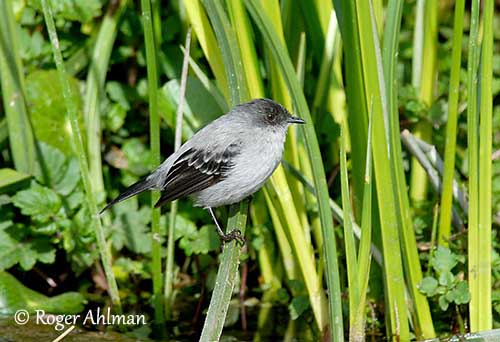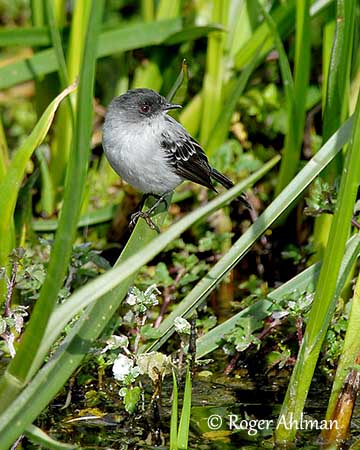
Fr: Tyranneau des torrents
Ang: Torrent Tyrannulet
All: Sturzbach-Kleintyrann
Esp: Piojito Guardarríos
Ita: Tiranno piccolo di torrente
Nd: Bergbeektachuri
Sd: Forsdvärgtyrann
Photographers:
Roger Ahlman
Pbase Galleries Peru and Ecuador
John Anderson
John Anderson Photo Galleries
Didier Buysse
Vision d’Oiseaux
Jean Michel Fenerole
Photos d’Oiseaux du monde
Ken Havard
My Bird Gallery & Flickr gallery 1 & Flickr gallery 2
Text by Nicole Bouglouan
Sources:
HANDBOOK OF THE BIRDS OF THE WORLD Vol 9 - by Josep del Hoyo - Andrew Elliot - David Christie - Lynx Edicions - ISBN: 8487334695
A GUIDE TO THE BIRDS OF COLOMBIA by Steven L. Hilty and William L. Brown - Princeton University Press – ISBN 069108372X
BIRDS OF SOUTH AMERICA – Passerines - by Robert S. Ridgely and Guy Tudor – HELM Field Guides – ISBN: 9781408113424
BirdLife International (BirdLife International)
Neotropical Birds – Cornell Lab of Ornithology
Wikipedia, the free encyclopaedia
Torrent Tyrannulet
Serpophaga cinerea
Passeriformes Order – Tyrannidae Family
INTRODUCTION:
The Torrent Tyrannulet is a small tyrant of the subfamily Elaeniini in the large family Tyrannidae.
It is fairly common along the rocky, fast-flowing streams or rivers, and can be seen perched on rocks in the middle of the streams or on overhanging branch above the water. It often flicks its tail while perched. This species is fairly common throughout its Central and South American range.

DESCRIPTION OF THE BIRD:
Biometrics:
Length: 11 cm
Weight: 7-8 g
The adult of nominate race (here displayed) has pale grey back and rump. The black upperwing shows two narrow whitish wingbars. The innermost flight feathers are edged white. The tail is black.
Chin and throat are whitish while the underparts are greyish-white, with darker greyish breast and flanks. Lower belly and undertail-coverts are white.
On the head, crown, nape and head sides are black. There is a semi-concealed white crown stripe.
Bill, legs and feet are black. The eyes are dark brown. The legs are sturdy, well-adapted to the rocky areas where the bird usually occurs.
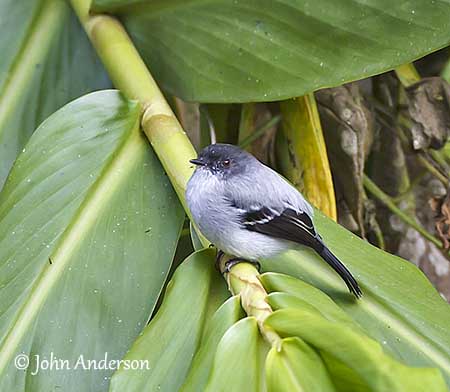
Both adults are similar, but the female has greyer top of head and the crown stripe is less visible or absent.
The juvenile has browner head, a brownish wash on the upperparts and mostly buffy wingbars.
SUBSPECIES AND RANGE:
The Torrent Tyrannulet has two recognized subspecies.
S.c. grisea (not displayed) is found in Costa Rica and W Panama. This race is much smaller and paler than nominate. The crown shows a smaller crown stripe.
S.c. cinerea (here described and displayed) is found on the Andean slopes from Colombia and Venezuela (Mérida), S to Bolivia (La Paz, Cochabamba).
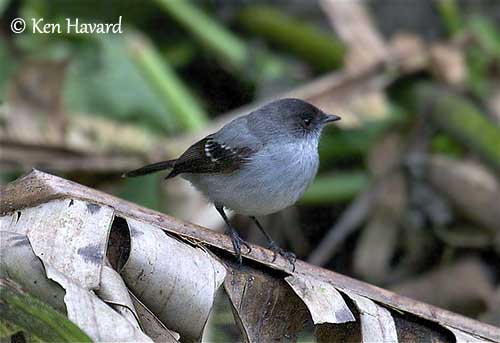
HABITAT:
The Torrent Tyrannulet is common along fast-flowing mountain streams and rivers. It occurs in forested areas, but also in semi-open terrain. It frequents the rocky margins of streams, between 700 and 2800 metres of elevation, although it can be recorded up to 3700 metres according to the range.
The numbers are decreasing down to the base of foothills where there are slower-flowing rivers.
CALLS AND SONGS: SOUNDS BY XENO-CANTO
The Torrent Tyrannulet utters loud, sharp « seep » sometimes given in series and audible above the stream noise.
The song is a duet of repeated “chip” or “seek-ti,ti,ti,ti,ti,ti”. This song is slower when given at dawn from a perch, while the bird is almost motionless.
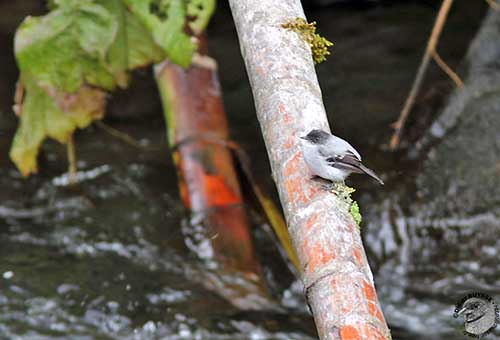
BEHAVIOUR IN THE WILD:
The Torrent Tyrannulet is an insect-eater and feeds mainly on flying insects such as dragonflies, moths, mayflies and caddisflies.
Its commonest feeding behaviour is by aerial hawking, but it also makes aerial sallies to water surface, rocks or vegetation along the river bank after flying insects.
It is often seen perched on boulders in the middle of the stream while flicking its tail upwards. They forage in pairs and patrol over small sections of the rocky streams.
The Torrent Tyrannulet is monogamous and defends its territory. The male sings and displays during the breeding season. It sometimes raises the crown feathers and the white crown stripe appears.
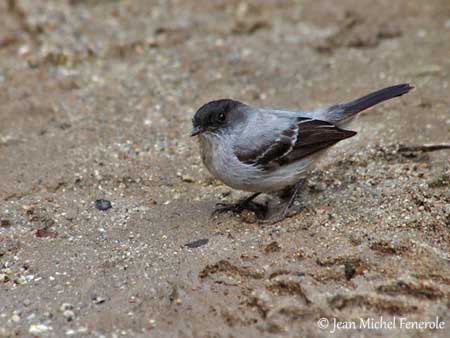
This species usually occurs in sedentary pairs which remain close to water, or occasionally venture out onto adjacent pastures.
The direct flight is low over water and fast.
REPRODUCTION OF THIS SPECIES:
The breeding season varies according to the range. The Torrent Tyrannulet breeds between January and June in Costa Rica, between May and September in Colombia, and from June to October in Peru.
The nest is a cup covered with moss on the outer part, while the inner cup is lined with downy feathers. It is placed on overhanging branch or vegetation, usually between 1 and 4 metres above the water. The nest is built by both adults.
The female lays 2 pale buff eggs and incubates alone during 15-18 days. Both parents feed and tend the chicks. Two weeks after hatching, the young are feathered and they fledge at about 17 days of age. They usually remain in family group during 5-6 weeks and then, they disperse to other section of the stream or river.
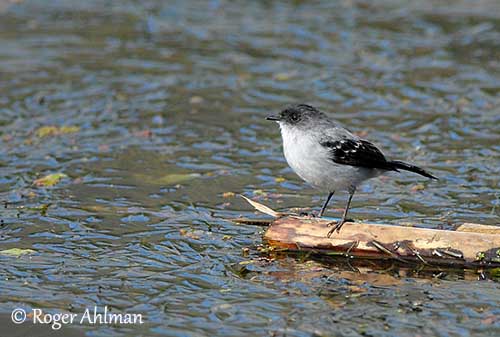
PROTECTION / THREATS / STATUS:
The Torrent Tyrannulet is generally common throughout its range, although it can be rare in Peru. It occurs in several protected areas in Costa Rica, Colombia, Venezuela, Peru and Bolivia.
However, the siltation of some watercourses may affect this species, like the construction of hydroelectric dams involving disturbances and causing the displacement of the birds towards lower areas.
But currently, the Torrent Tyrannulet is evaluated as Least Concern.
